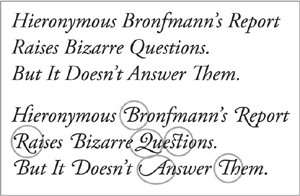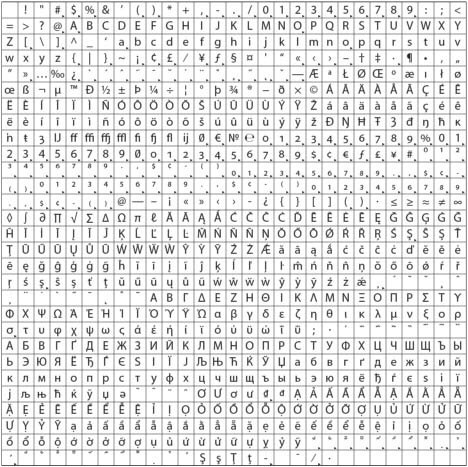Font Flavors
| Fonts come in several formats: PostScript (often also referred to as Type 1), TrueType, and OpenType. Within those major species, there are subspecies, but it's sufficient to know the major species. We'll ignore ancient Mac system fonts, which were just bitmap information. PostScript (Type 1) FontsWe were all raised to believe that PostScript fonts were the Only Right Way, convinced that any other font format was evil (pronounced as in old horror movieseve-yil). In the earlier days of desktop publishing, this was a well-founded belief, because early RIPs couldn't handle TrueType. PostScript fonts consist of two files: A screen component for onscreen display and a printer component that contains PostScript instructions for actually drawing the character. You may hear these two components described as screen font and printer font on the Macintosh. On Windows, you'll see .pfm (printer font metrics) and .pfb (printer font binary) files. The .pfm file is the equivalent of the Macintosh screen font, and the .pfb file is the printer font. On either platform it takes the pair together to constitute the font. Since it's made of pixels, the screen component alone can't provide acceptable resolution for output, so if you misplace the printer font, you're out of luck. Prior to Macintosh OS X, it was necessary to have the screen font to provide onscreen display of a PostScript font, but OS X can rasterize a printer font for onscreen display once it's activated without needing a companion screen font to do so. Font activation applications, such as Extensis™ Suitcase, Suitcase Fusion, or FontAgent Pro from Insider Software won't activate a lone printer font without its companion screen font, but some applications such as Adobe InDesign activate printer fonts placed in their own private fonts folders. Placing a PostScript printer font in InDesign's fonts folder makes it available to InDesign on both Windows and Macintosh. In either case, the operating system handles the onscreen display without having a screen font. TrueType FontsThe TrueType format was the result of a collaboration between Apple Computer and Microsoft and consists of a single file (that is, no separate screen and printer font component). Thus there is no need to keep track of two separate components for screen and print. However, in more primitive timessay, 1993just mentioning TrueType could strike terror in the heart of a prepress operator. Earlier PostScript RIPs could not interpret TrueType fonts, so it was routine to use a font-conversion utility to change the flavor of the font to PostScript. While such conversions enabled the job to be processed by a RIP, they often resulted in slight translation errors and some compromise of the hinting stored in the TrueType version of the font. Consequently, text appearance was altered, however slightly, from the designer's expectations. But we were desperate people in those times, and we accepted the slight differences in the interest of actually getting the job to print. Fast-forward to current times. It's no longer necessary to jump through these treacherous hoops. RIPs can now process TrueType just as easily as PostScript fonts. Really. There is no longer any need to sneer at TrueType fonts as being somehow inferior. Admittedly, if you buy TrueType fonts in a $9.95 font collection called Larry's Boatload o'Fonts, there's a chance that they won't be well behaved. But that isn't because they're TrueType fonts. It's because Larry builds lousy fonts. OpenType FontsOpenType fonts are single-file fonts and do not have separate screen and printer fonts to keep track of. But here's where the real font fun begins. OpenType fonts are cross platform. This doesn't mean that Adobe Garamond Pro comes in a Macintosh version and an identical Windows version. Instead, the same font file can be used on a Mac or on a PC with no special handling. But, as the late night TV ads say: Wait, there's more. Whereas PostScript fonts are limited to a paltry 256 characters (isn't that enough?), OpenType fonts can contain more than 65,000 glyphs. A glyph is any distinct letterform, such as a number, a lowercase p, or an ampersand. This allows a font designer to include swashes, contextual ligatures, titling alternateseven fractionsall in one font. The entirety of a font family that previously required separate expert and titling sets can now be contained in one font. See Figure 6.1 for a glimpse of just a few of OpenType's possibilities. Figure 6.1. Adobe Garamond Pro is a lovely font even without invoking its special OpenType features (top). But look what happens when Swashes and Discretionary Ligatures are turned on (bottom). Not all OpenType fonts contain glyphs in every one of those 65,000 available character positions. For example, one font may have swashes, but another may not. However, the adherence to Unicode mapping ensures that a character exists in the same position from font to font. Unicode is a standard that provides a unique universal identifier for every character, regardless of language, application, or platform. For more information, visit the Unicode Web site (www.unicode.org). If you set text using some of the special diacritical characters in Caslon Pro, for example, and then change the font used to Garamond Pro, the diacriticals are intact because they exist in both fonts. You can use OpenType fonts without fear of imaging problems. They are compatible with all recent RIPs, and all current font-management software supports OpenType. Not using font-management software? OpenType fonts can be activated by the built-in Font Book application on the Macintosh and by the Windows Fonts control panel. Or you can drop them in the Macintosh system fonts folders to make them available to all applications (although it's preferable to use font management software). And having OpenType fonts doesn't mean you have to stop using the PostScript and TrueType fonts you already have. The benefits of OpenType extend far beyond typographic beauty. One of the motivations for the OpenType format was to provide multilingual support. In Figure 6.2, you can see the extensive character set in just one font, Myriad Pro from Adobe Systems. Figure 6.2. Multilingual support available within the OpenType font Myriad Pro, viewed in the InDesign Glyphs palette. You won't be able to use all 65,000 glyphs unless you're using software that recognizes the additional features. Adobe InDesign, Illustrator, and Photoshop can see and use the entire contents of an OpenType font, whereas QuarkXPress through version 6.5 has blinders on, and it can only utilize the same old 256 characters. QuarkXPress 7.0 offers support for the complete range of OpenType features. Adobe has converted its entire font library to OpenType and will no longer be offering PostScript Type 1 fonts. It's easy to spot OpenType fonts from Adobe: They have Std or Pro as part of their names. Adobe is not the only font vendor marketing OpenType fonts. Most major font vendors now offer OpenType. Given the linguistic support and the enhanced typographic features offered by OpenType fonts, it's easy to see that it's the font format of the future. And it's here today, unlike those flying automobiles we've been waiting for. Note The Std is short for Standard, indicating an Adobe OpenType version of a previously available PostScript Type 1 font. Adobe OpenType fonts with the Pro indicator have more expanded glyph sets and are often the result of combining what once were expert font sets and their base companions.
Macintosh OS X System FontsMacintosh system fonts such as Geneva, Monaco, Chicago, and Charcoal had traditionally been easy to spot because of their distinctive names. But with the introduction of OS X, Apple threw a monkey wrench into the font wars by including system fonts named Helvetica, Helvetica Neue, and Times Roman, just like their PostScript cousins. Under the hood, these are TrueType fonts, but you'll see them described as dfonts, a moniker derived from the fact that the fonts are data-only, and not a two-headed file consisting of a data fork and a resource fork. (If this doesn't mean much to you, don't worry.) Macintosh dfonts aren't inherently evil, but they are problematic because their names are indistinguishable from their PostScript counterparts. If the job is created by multiple people who are using different versions of a font, this may result in font substitution and consequent reflow. Since they're system fonts, they're active by default. To use the PostScript fonts of the same names, you have to sneak up on the dfonts to control their activation or deactivation by using dedicated font-management software as described in the earlier section, "PostScript (Type 1) Fonts." Additionally, dfonts don't work under OS 9 because they're not recognized as fonts by the OS 9 operating system or its font-management schemes. If you're still jumping back to OS 9 to use earlier versions of software such as QuarkXPress 4.x or 5.x, this can complicate your font usage. Imagine that you have used a dfont in a QuarkXPress 6.0 file created in Macintosh OS X, and then saved the page-layout file down for QuarkXPress version 5.0. A user of QuarkXPress 5.0 will open the file under OS 9, and the dfont will not be available. They'll be forced to substitute a similar font, possibly leading to text reflow. One solution is to use the dfontifier utility from Mark Douma (http://homepage.mac.com/mdouma46/dfont/dfont.html) to convert dfonts to a font format that is recognized under OS 9. OpenType fonts are innocent bystanders in this battle. Their names distinguish them from TrueType, PostScript, and dfont files. As you can see in Figure 6.3, the OpenType version of Times is named TimesLTStd, making it much easier to pick it out of the pack. Figure 6.3. Sign of the Times. On the left, Macintosh OS X icons for PostScript screen font (left) and printer font (second from left). The OpenType icon is in the center, and Macintosh dfont is on the right. The icons aren't exactly obvious, are they? Windows System FontsPC users may now revel in the fact that, starting with Windows 2000, their system fonts are OpenType fonts. In fact, the birth of OpenType is the result of a collaboration between Adobe Systems and Microsoft. The Arial system font has the ability to display an extensive character set, including Greek, Hebrew, and Arabic characters. Multiple Master FontsThe term Multiple Master probably elicits as much fear in a prepress department as yelling "TrueType," and for much the same reasonfear of the unknown. Adobe's Multiple Master fonts were a great idea: Start with a PostScript font, and then give users the ability to create multiple weights, angles, and widths (such as condensed or extended) of a single font. It was an enlightened idea. The problems arose from a lack of education. It wasn't obvious how to make all the cool variants, how to collect the variants necessary for your job, or how to ensure that the print service provider knew how to use them. So the Multiple Master concept sort of died on the vine. Its creative promise was never fully realized, and it's been phased out as an available font product. However, Multiple Master technology is still used for display and printing when fonts are missing in a PDF and for displaying text when fonts are unavailable for an InDesign or Illustrator file. Substituting One Font Species For AnotherA variation on the old joke:
When you collaborate on designs, try to avoid substituting a TrueType version of a font for a PostScript version, or vice versa. Don't use an OpenType font instead of the file creator's original font choice, despite your conviction that it's somehow better. You may get lucky, but you're risking type reflow. This is particularly treacherous if you move a job between platforms. A Windows font and its Macintosh namesake may both be PostScript, but that's still no guarantee that they were created by the same foundry with the same nuances. |
EAN: 2147483647
Pages: 132

